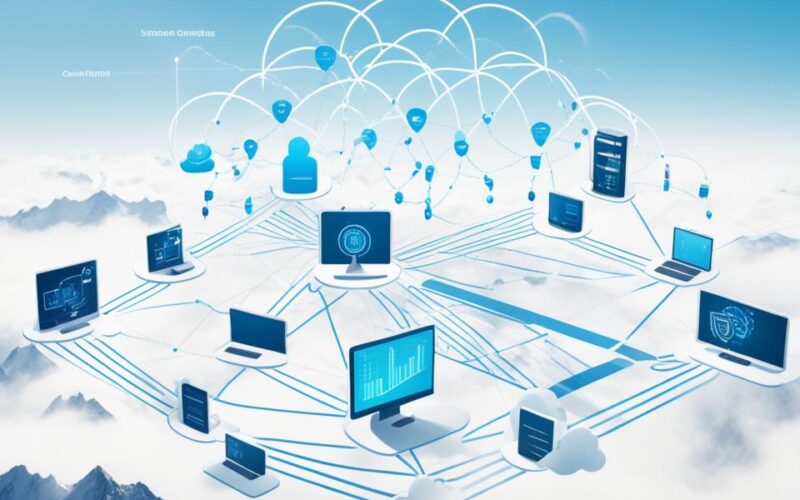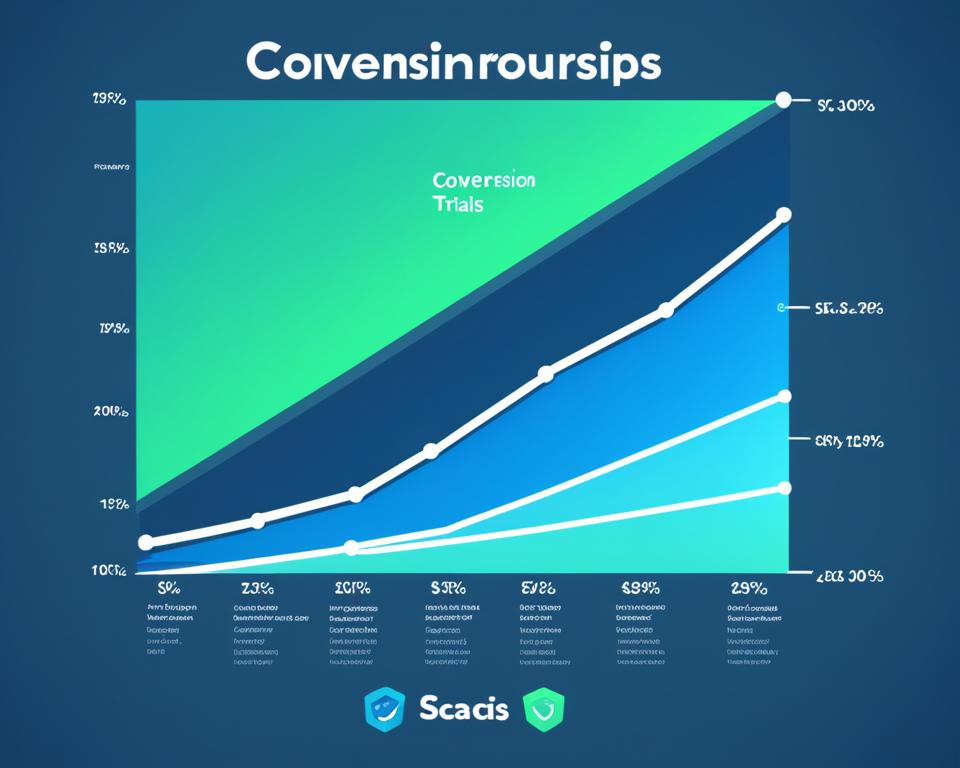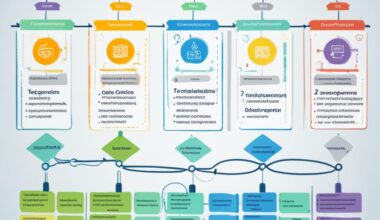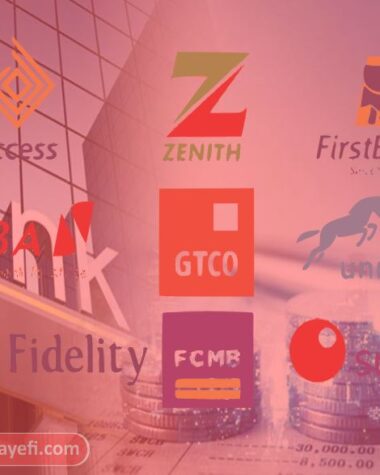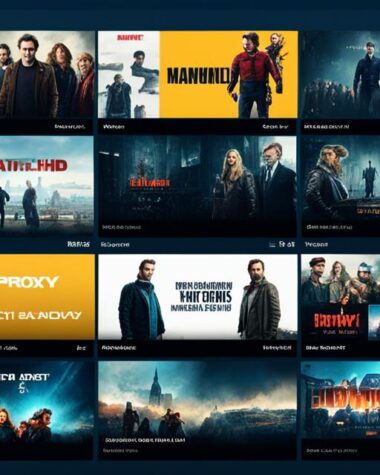Did you know that cloud-based applications are projected to have a market size of $266.4 billion by 2025?
SaaS software distribution plays a crucial role in making these cloud-based applications available to customers. It involves implementing effective strategies and utilizing various channels to reach a wider audience, convert leads into customers, increase sales, and build a strong customer base.
In this article, I will explore different methods of SaaS software distribution, including direct sales, channel sales, online app marketplaces, free trials, freemium models, self-service distribution, referral programs, content marketing, social media marketing, and email marketing. Join me as we delve into each distribution channel and discover how they can help businesses deliver their software to the right audience.
Direct Sales
Direct sales is a time-tested method of distributing SaaS software, wherein a dedicated sales team directly engages with potential customers to sell the software. It allows for personalized interactions and tailored presentations that can effectively demonstrate the value and benefits of the software. While direct sales can be highly effective in converting leads into customers, it can also be costly and time-consuming. Therefore, it is crucial to invest in a qualified sales team that possesses the necessary industry knowledge and sales expertise to effectively communicate the value proposition of the software.
A well-defined sales strategy is also vital for successful direct sales distribution. It involves setting clear objectives, identifying target customer segments, and establishing a structured approach to lead generation, prospecting, and closing deals. By implementing a comprehensive sales strategy, a SaaS company can optimize its direct sales efforts and maximize the conversion rate of potential customers into paying clients.
Direct sales require a qualified and skilled sales team, along with a well-crafted sales strategy, to effectively distribute SaaS software.
Channel Sales
Channel sales is a popular distribution strategy for SaaS software. It involves partnering with resellers and system integrators who have established networks and expertise in specific markets. These channel partners play a crucial role in promoting and selling the software, expanding reach to new markets and customer segments.
By leveraging the relationships and industry knowledge of channel partners, SaaS companies can tap into untapped customer bases and enter new geographical regions. The partners act as an extension of the company’s sales force, representing the software to potential customers and providing valuable insights and support throughout the sales cycle.
When choosing channel partners, it is important to align their capabilities and target market with the software’s value proposition. Resellers and system integrators that cater to the same customer segments and understand the specific needs of those segments will yield the best results. Working with partners who are experienced in selling software will also ensure smoother integration and deployment for customers.
To foster successful channel sales, SaaS companies must provide comprehensive support to their partners. This includes offering training programs, sales enablement resources, and ongoing technical assistance. By equipping channel partners with the necessary tools and knowledge, companies can empower them to effectively promote and sell the software.
Channel sales also opens opportunities for upselling and cross-selling complementary products or services. Through collaboration with partners, SaaS companies can identify additional needs or pain points of customers and present bundled solutions that add value and increase revenue.
Benefits of Channel Sales
- Expanded reach to new markets and customer segments
- Tapping into the expertise and industry knowledge of channel partners
- Utilizing established networks of resellers and system integrators
- Opportunities for upselling and cross-selling
Challenges of Channel Sales
- Choosing the right channel partners that align with target markets
- Ensuring effective communication and collaboration with partners
- Managing and supporting a diverse network of channel partners
Channel Sales vs. Direct Sales
| Channel Sales | Direct Sales |
|---|---|
| Expands reach to new markets | Direct control over sales process |
| Taps into partner networks | Builds direct relationships with customers |
| Leans on partner expertise | Requires qualified sales team |
| Potential for upselling and cross-selling | Direct oversight of upselling and cross-selling |
Online App Marketplaces
Online app marketplaces are an essential distribution channel for SaaS software, allowing businesses of all sizes to reach a global audience. Platforms like AppSumo, PitchGround, and DealMirror provide a space for listing and selling software, attracting potential customers from around the world.
Being part of an online app marketplace gives SaaS companies the opportunity to tap into a vast customer base. With a global audience at their fingertips, businesses can expand their reach and target new markets that were previously inaccessible. These marketplaces offer a level playing field, allowing startups and established companies alike to showcase their software and compete on a global scale.
However, the competition within online app marketplaces is fierce. With numerous software options available, it’s crucial for SaaS companies to stand out from the crowd and capture the attention of potential customers. To succeed in this highly competitive environment, it’s essential to invest in well-designed software that meets the specific needs of the marketplace audience.
The online app marketplace provides a window of opportunity for businesses to reach a global audience. However, to succeed in this competitive landscape, it is crucial to create software that not only meets the needs of customers but also outshines the competition.
By offering unique features, personalized user experiences, and exceptional customer support, SaaS companies can differentiate themselves from competitors and establish a strong presence within online app marketplaces. It’s important to continually adapt and improve the software based on customer feedback and marketplace trends to maintain a competitive edge.
| Advantages | Challenges |
|---|---|
|
|
Free Trials and Freemium Models
Offering free trials is a powerful strategy that not only generates leads but also significantly increases conversion rates for SaaS companies. By providing potential customers with the opportunity to try out the software before committing to a purchase, free trials allow them to experience the value and benefits firsthand.
During the free trial period, users have the chance to explore the software’s features, functionalities, and performance, enabling them to make an informed decision. This hands-on experience builds trust and confidence in the product, leading to higher conversion rates as users are more likely to convert into paying customers once they experience the value and benefits.
Freemium models, on the other hand, offer users a basic version of the software for free while charging for premium features. This model entices potential customers with the ability to use the software and get a taste of its capabilities, all without any financial commitment.
The freemium model creates a win-win situation for both the users and the SaaS company. Users get to experience the software’s core functionalities, gaining value and solving their pain points. Meanwhile, the SaaS company has the opportunity to upsell premium features and monetize the software, ensuring the sustainability of the business.
When designing free trials and freemium models, it is crucial to strike the right balance. Providing enough value during the trial period to engage potential customers and showcase the software’s capabilities is key. Simultaneously, offering premium features that are irresistible and demonstrate the added value of upgrading to a paid plan stimulates conversions.
Ultimately, a well-executed free trial or freemium model strategy can significantly contribute to the growth and success of a SaaS company by attracting and converting a larger customer base.
Benefits of Free Trials and Freemium Models:
- Increased conversion rates compared to not offering free trials
- Builds trust and confidence among potential customers
- Allows users to experience the software’s value firsthand
- Captures leads and generates interest in the product
- Upsell opportunities for premium features
- Ensures the sustainability of the business
Free Trials vs. Freemium Models
| Free Trials | Freemium Models |
|---|---|
| Users have full access to all features during the trial period | Basic version of the software is available for free |
| Limited time period for the trial | No time limit for using the basic version |
| No financial commitment required | Users can choose to upgrade to access premium features |
| Promotes user engagement and product exploration | Provides a taste of the software’s capabilities |
| Higher chance of converting potential customers into paid users | Opportunities for upselling premium features |
As you can see from the comparison table above, both free trials and freemium models have their unique advantages and can be effective in driving conversions and revenue for SaaS companies. It is essential to carefully consider your target audience, product offering, and business goals when deciding which approach to adopt.
Self-Service Distribution
Self-service distribution is a convenient option for customers to sign up and start using SaaS software without the need to contact a sales team. This approach allows users to have more control over their onboarding experience, empowering them to explore and utilize the software at their own pace. A user-friendly onboarding process is essential to ensure a smooth and satisfying experience for customers.
By providing clear instructions, intuitive interfaces, and helpful resources, SaaS companies can guide users through the onboarding process seamlessly. The objective is to make it easy for customers to understand the software’s features, functionality, and how to maximize its benefits. When users have a positive onboarding experience, they are more likely to continue using the software and achieve their desired outcomes.
Efficient self-service onboarding also plays a crucial role in user retention. When customers can get started with the software quickly and easily, they are more inclined to continue using it in the long run. User retention is essential for SaaS companies as it helps drive customer loyalty, recurring revenue, and positive word-of-mouth referrals.
Offering resources and support to customers throughout their journey is essential for successful self-service distribution. Frequently asked questions (FAQs), knowledge bases, tutorials, and user forums can provide valuable assistance to customers, enabling them to troubleshoot common issues and explore advanced features independently. This self-serve support ecosystem is a cost-effective way for SaaS companies to scale their operations while ensuring customer satisfaction and retention.
“Self-service distribution empowers users to explore and utilize SaaS software at their own pace, resulting in a more satisfying onboarding experience.”
Benefits of Self-Service Distribution:
- Convenience for customers to sign up and get started immediately
- Greater control and flexibility in the onboarding process
- Improved user retention rates
- Scalability for SaaS companies without increasing support costs
Challenges of Self-Service Distribution:
- Ensuring a seamless onboarding experience without direct human interaction
- Addressing user questions and concerns effectively through self-serve resources
- Differentiating the software through user-friendly interfaces and comprehensive documentation
| Key Steps | Description |
|---|---|
| Create Clear User Guides | Develop comprehensive documentation to guide users through setup, configuration, and initial usage of the software. |
| Design Intuitive User Interfaces | Create an intuitive and user-friendly interface that promotes self-discovery and ease of navigation. |
| Offer In-App Tutorials | Provide step-by-step tutorials or interactive walkthroughs within the software to assist users in learning key features. |
| Implement Contextual Help | Integrate contextual help elements such as tooltips, guided pop-ups, and contextual links to assist users in real-time. |
| Enable Live Chat Support | Offer live chat support options for users to receive immediate assistance during onboarding and beyond. |
| Create Video Tutorials | Develop video tutorials or screencasts that visually demonstrate how to perform specific tasks or use advanced features of the software. |
Referral Programs and Content Marketing
Referral programs and content marketing are two powerful strategies that can help SaaS companies generate leads and build trust with potential customers.
A referral program allows existing customers to become advocates for your software by referring their friends and colleagues. By incentivizing referrals and making it easy for customers to refer others, you can tap into their networks and reach new leads. Referral programs not only help you acquire new customers but also provide social proof and credibility, as people trust recommendations from their peers.
Content marketing, on the other hand, involves creating and publishing high-quality content that is relevant and valuable to your target audience. This can include blog articles, whitepapers, case studies, videos, and more. By sharing valuable insights and expertise, you can position your SaaS company as an industry expert and build trust with potential customers. Content marketing also helps in lead generation by attracting organic traffic from search engines and establishing your brand as a go-to resource in the industry.
When implementing a referral program, it is important to design a valuable incentive that motivates customers to refer others. This can be in the form of discounts, exclusive access to features, or even monetary rewards like credits or cash. You should also make the referral process as simple as possible, providing clear instructions and a user-friendly interface for customers to refer others.
For content marketing, focus on creating high-quality content that addresses common pain points and challenges faced by your target audience. This will not only attract their attention but also showcase your expertise and ability to solve their problems. Use search engine optimization (SEO) techniques to ensure your content ranks well in search results and drives organic traffic to your website. Additionally, leverage social media platforms and email marketing to amplify the reach of your content and engage with your audience.
To summarize, referral programs and content marketing are effective strategies to generate leads and build trust in the SaaS industry. By incentivizing referrals and providing valuable content, you can attract new customers and establish your brand as a trusted authority in the market.
| Referral Programs | Content Marketing |
|---|---|
| Tap into existing customer networks | Position your company as an industry expert |
| Acquire new leads and customers | Generate organic traffic from search engines |
| Build social proof and credibility | Showcase your expertise and solutions |
| Incentivize referrals with valuable rewards | Address pain points and challenges |
| Streamline the referral process | Utilize SEO techniques for better visibility |
Conclusion
When it comes to SaaS software distribution, choosing the right channels and methods is crucial for reaching the target audience effectively. With a wide range of options available, including direct sales, channel sales, online app marketplaces, free trials, freemium models, self-service distribution, referral programs, content marketing, social media marketing, and email marketing, it’s important to carefully consider the benefits and limitations of each channel. The best distribution strategy will depend on the specific business and target market.
Direct sales can be effective but expensive and time-consuming, requiring a qualified sales team and a strong sales strategy. Channel sales, on the other hand, leverage partners such as resellers and system integrators to reach new markets and customer segments. Online app marketplaces provide access to a global audience but also face high competition, necessitating well-designed and standout software. Free trials and freemium models can generate leads and convert potential customers, but must strike a balance between value and sustainability.
Self-service distribution allows for a smooth onboarding experience and higher user retention rates, while referral programs and content marketing are effective in generating leads and building trust. Ultimately, the right distribution channels and methods will depend on the goals and resources of the SaaS company. By carefully evaluating each option and considering their alignment with business objectives and target audience, SaaS companies can optimize their software distribution and maximize their success in the market.
FAQ
How is SaaS software distributed?
SaaS software is distributed through various channels and strategies, including direct sales, channel sales, online app marketplaces, free trials, freemium models, self-service distribution, referral programs, content marketing, social media marketing, and email marketing.
What is direct sales?
Direct sales is a traditional method of distributing SaaS software. It involves having a sales team that reaches out to potential customers and sells the software directly.
How can I succeed with direct sales?
To succeed with direct sales distribution, it is important to invest in a qualified sales team and develop a strong sales strategy.
What is channel sales?
Channel sales involve selling SaaS software through partners such as resellers and system integrators.
How can channel sales help reach a wider audience?
Channel sales can help reach a wider audience by leveraging the networks and expertise of partners, opening doors to new markets and customer segments.
What are online app marketplaces?
Online app marketplaces are platforms where SaaS software can be listed and sold, providing access to a global audience and businesses of all sizes.
How can I stand out in online app marketplaces?
To stand out in online app marketplaces, it is crucial to ensure that the software is well-designed, meets the marketplace audience’s needs, and stands out from the competition.
What are free trials?
Free trials are an effective way to generate leads and convert potential customers into paying customers.
Why are freemium models effective?
Freemium models offer a basic version of the software for free and charge for premium features, providing value to potential customers while ensuring the sustainability of the business.
What is self-service distribution?
Self-service distribution allows customers to sign up for and start using SaaS software without contacting a sales team.
How can I improve self-service distribution?
To improve self-service distribution, it is important to have a user-friendly onboarding process and provide resources and support to customers.
How can referral programs and content marketing help in SaaS software distribution?
Referral programs incentivize existing customers to refer others, generating new leads and acquiring new customers. Content marketing helps generate leads and build trust by creating and publishing high-quality content that is relevant and valuable to the target audience.
What should I consider when choosing distribution channels?
When choosing distribution channels, it is important to carefully consider the benefits and limitations of each channel and choose the ones that align with the goals and resources of the SaaS company.
